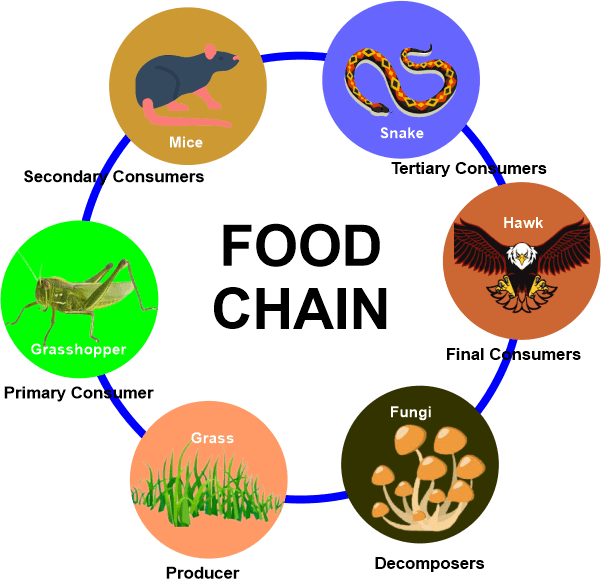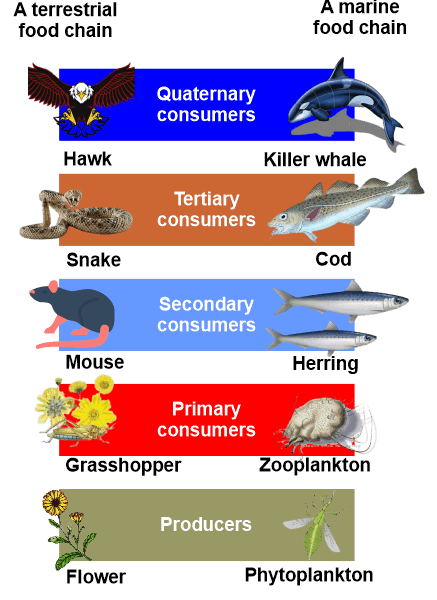Food Chain DefinitionThe exchange of energy and the cycling of nutrients make up the intricate and delicate equilibrium of the food chain. Recognizing the significance of the food chain and its function in the ecosystem is crucial for humans as well as for the survival of the environment. People are better able to decide on their own consumption and the effects it has on the environment by having a better grasp of the food chain. With this information, people will be better able to preserve and safeguard the environment, which is crucial for the survival of the world. 
So, in this article, we'll study everything we need to know about the food chain. Definition: What is Food Chain?A food chain is a linear sequence of organisms that feed on each other, transferring energy from one species to another. The sequence in which various creatures receive their energy from the environment is referred to as the "food chain". The transport of energy across an ecosystem may be understood by using the ecological principle of food chains. An extensive network of living things that are all dependent on one another to survive is referred to as a food chain. Given that it serves as the backbone of the whole ecosystem, the food chain is one of the most basic elements of the environment. Numerous species from different groups are connected by a food chain by way of a certain order in which they consume one another. The exchange of energy and the cycling of nutrients make up the complicated and delicate equilibrium of the food chain. The energy that the plants create is transferred to the animals that eat the plants and then transferred the energy further to the predators. Repeating this cycle causes the energy to finally be lost as heat, which is then released back into the environment. Levels of Food ChainThe food chain ascends the series in a connected line, starting at the base, which is composed of producer organisms. Levels in a food chain are referred to as the trophic levels, which are the rungs that follow each other in a food chain. Every living thing has a certain trophic level, which is defined by where it is in the food chain. A food chain has several different trophic levels, such as: 
Primary ProducersAutotrophs make up the fundamental or foundation level of the food chain. These are creatures that can use a material like carbon dioxide to make their own food and convert it to energy with the assistance of sunshine. Plants and algae make up this group. They don't eat other living things; instead, they gather nutrients from the soil or the water and create their own food through photosynthesis. We refer to them as main producers or primary producers. The sun's energy powers the organisms at the start (at the bottom in the image shown) of the food chain. Primary ConsumersThe second trophic level is made up of heterotrophic species, or those that consume the biomass of the first trophic level, the autotrophs. They are the herbivores, which also include considerably bigger animal herbivores like mice, deer, cows, and elephants, as well as the microscopic crustacean zooplankton that eats the minute algae cells off the surface waters of lakes, ponds, and seas. Herbivores use the nutrients and fixed energy in the autotrophic material they consume to power their own metabolic activities and promote personal development. Secondary ConsumersAnimals that consume herbivores are the next link in the chain and are referred to as secondary consumers. An example of one of them is a snake that consumes bunnies. Snakes are, therefore, secondary consumers. Tertiary ConsumersThe next level of consumers is tertiary consumers. Tertiary consumers, such as killer whales, are carnivores that eat other carnivores. Sea lions and seals are prey for killer whales. These are predators that devour octopuses, squid, and fish. Quaternary ConsumersThe quaternary consumers occupy the next level of the food chain. They generally devour secondary consumers and are predatory creatures. They are predators that live at the top of a food chain and are not preyed upon by other animals. They are also referred to as apex predators, alpha predators, or apical predators. Some examples of quaternary consumers include lions, wolves, polar bears, humans, and hawks. DecomposersPlants and animals that have died are decomposed by decomposers. The waste from other creatures is also broken down by them. Due to their ability to provide a steady supply of nutrients for the primary producers, they are a crucial component of the food chain. On the one side, plants would be unable to obtain their energy without the decomposers, and on the other, the environment would be a wasteland of trash and dead things. Thus, decomposers play a crucial role in the food chain. Importance of Food Chain
Types of Food ChainThere are mainly two types of food chains, namely the grazing food chain and the detritus food chain. Let us discuss each in brief: Grazing Food ChainGreen plants are the first link in the grazing food chain, followed by herbivores and then predators. In a grazing food chain, the lowest trophic level receives energy from photosynthesis, and the first energy transfer occurs from plants to herbivores. This sort of food chain is used by the majority of ecosystems since autotrophs are the basis of all ecosystems on Earth. Therefore, this kind of cycle is dependent on the accumulation and transmission of autotrophic energy to herbivores. The majority of natural ecosystems have this kind of food chain. Let us have a look at the following example of the grazing food chain: Phytoplankton → Zooplankton → Small fish → Larger fish → Birds →Decomposer In this food chain, the phytoplankton is primarily responsible for producing food (or organic matter) through photosynthesis. Phytoplankton is consumed by multicellular and acellular organisms like zooplankton. The zooplankton is consumed by tiny fish, lobsters, and crabs. The smaller fish, lobster, or crabs are eaten by the larger fish. The larger fish are then consumed by mammals, reptiles, and birds. After these animals pass away and are subsequently decomposed by microbes, the food chain is completed. Grasses → Rabbit → Fox In this instance, the main producers in the food chain are the grasses. They produce food through a process called photosynthesis, which makes use of the chlorophyll in their leaves and stems when there is sunshine. The energy from the grasses is transferred to the rabbits through their intake when they eat the grasses. Because it is a carnivore and a heterotroph, the fox must consume the rabbit because it is unable to produce its own food. Detritus Food ChainAlgae, bacteria, fungi, protozoa, mites, insects, worms, and other organisms and plants are all a component of the detritus food chain, which begins with dead (decomposing) organic matter. Dietary energy is used by decomposers and detritivores, which is subsequently devoured by smaller animals like predators. Larger carnivores like frogs, snakes, and other predators eat smaller carnivores like maggots. Primary consumers known as detritivores eat detritus, which includes fungus, bacteria, protozoans, and other creatures. The "decomposer food chain" is another name for this food chain. Let us have a look at the example of the detritus food chain: Dead Leaves → Woodlice → Black Birds Woodlice eat things like cellulose from downed trees and decaying leaves. The blackbirds consume these woodlice. As a consequence of the detritus food chains, carbon dioxide and inorganic compounds like nitrates, sulfates, and phosphates are created after the blackbird dies. The detritus cycle often ends with no combustible organic material remaining. ConclusionIn summary, the food chain plays a significant role in nature and the environment. It gives all living things food and energy and contributes to the ecosystem's stability and balance. The maintenance of the food chain and its defense against any harmful practices that can interfere with it is our duty as humans. By comprehending the functioning of the food chain and its significance to the environment, we may contribute to the preservation of the natural order and guarantee that all living things have access to the food they require to exist.
Next TopicGermination Definition
|
 For Videos Join Our Youtube Channel: Join Now
For Videos Join Our Youtube Channel: Join Now
Feedback
- Send your Feedback to [email protected]
Help Others, Please Share










